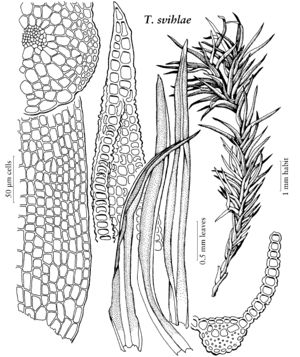Tuerckheimia
Öfvers. Finska Vetenskaps-Soc. Förh. 52A(7): 1. 1910 ,.
| Taxon | Illustrator ⠉ | |
|---|---|---|
 | Tuerckheimia svihlae | Patricia M. Eckel |
Plants in turfs, light to dark green with a somewhat bluish cast, glaucous. Stem to 2.5 cm, hyalodermis rarely distinct, sclerodermis absent or weakly developed, central strand present; axillary hairs to 16 cells long, basal-cell occasionally brown, other axillary hair cells hyaline. Leaves crowded in the stem apex, spreading from the base with incurved tips, weakly contorted to crisped when dry, widespreading when moist; oblong to linear-lanceolate, with lamina often of even width to the base, subtubulose, to 3.2 mm; base undifferentiated to short-ovate; margins plane to weakly incurved, entire or occasionally deeply lobed-dentate, sometimes with 2-stratose areas; apex acute, often narrowly so; costa percurrent and ending in an apiculus or excurrent as a stout, short-to-elongate mucro, adaxial outgrowths absent, adaxial superficial cells quadrate to shortrectangular, 4–6 cells across costa at mid leaf; transverse-section circular to ovate, adaxial epidermis present, adaxial stereid band distinct, 2 or more guide cells in one layer, hydroid strand absent, abaxial stereid band distinct, semicircular to lunate, abaxial epidermis occasionally present, weak; proximal laminal cells weakly differentiated in a small group, rectangular, somewhat larger than distal cells, 1–2: 1, walls evenly thickened; distal laminal cells subquadrate, hexagonal to elliptical, ca. 10–14 µm wide, 1: 1 (–2); papillae typically massive, variously lobed or simple to multifid; cell-walls evenly thickened, lumens rounded to subangular, superficial walls subconvex. Specialized asexual reproduction absent. Sexual condition dioicous. Perichaetia terminal, leaves abruptly sheathing at the base, otherwise similar to cauline leaves. Seta to 8 mm. Capsule stegocarpous, theca ellipsoidal to short-cylindric, ca. 1–1.5 mm, annulus of persistent non or strongly vesiculose cells; operculum long-rostrate of cells in straight rows; peristome absent or rudimentary, papillose. Calyptra unknown. Spores 8–13 µm. Laminal KOH color reaction yellow.
Distribution
se United States, Mexico, Central America, e Asia
Discussion
Species 4 (1 in the flora).
Tuerckheimia was considerably revised by R. H. Zander (1978). It is characterized by narrow leaves with acute apices, plane margins and peculiar, massive papillae, best seen in the distal portion of the leaf. Tuerckheimia calculosa R. H. Zander & P. M. Eckel of the West Indies and Mexico, which possesses similar papillae characteristics, has been transferred to its own monotypic genus [Quaesticula navicularis (Mitten) R. H. Zander] on the basis of ligulate leaves with cucullate apices and strongly involute margins, subpercurrent costa, and well-developed peristome (Zander 1993).